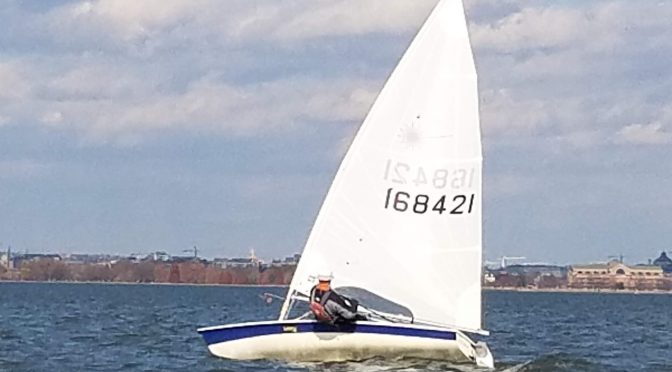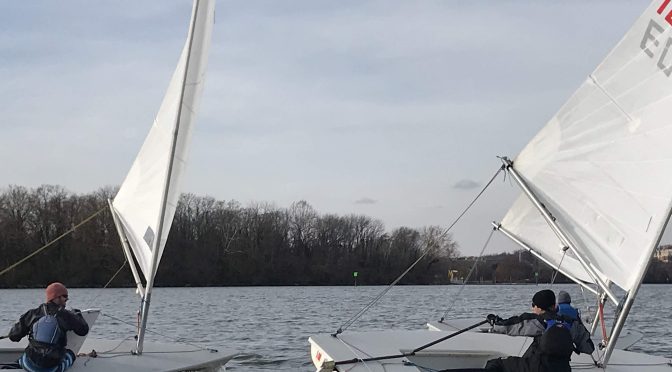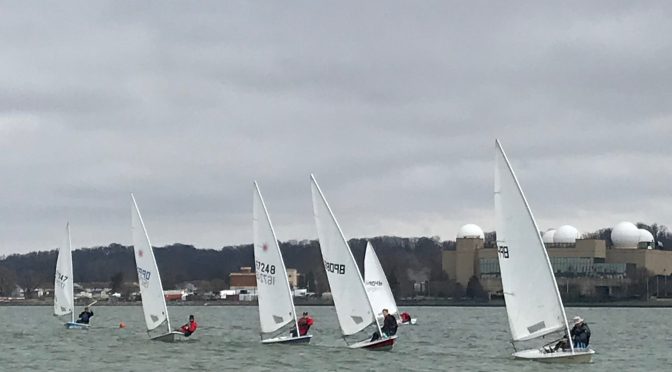During the skippers meeting 11 competitors were left staring across the river with a light 5 kt westerly. That didn’t last long. The average throughout the day was likely between 12 to 16 kts, although we did experience some lulls throughout portions of the racing. The largest gusts were roughly 21 kts, which was likely during the first race (I’m gonna claim that’s the gust I deathrolled on). Race Committee efficiently ran a total of 5 races, and even swiftly reset the course roughly midway through once the wind clocked around more northwest. High tide was roughly 10:10 am and low tide was scheduled for 4:35 pm.
Core Strategy
I’m not sure I had any tactical revelations for the day regarding shifts or tide. Instead, I had two main focuses for the day, typically starting as close to the committee boat as possible and boat control. By starting near the boat, I was trying to place myself in a position to sail on my own without interacting with the fleet. If I got away clean great, if not, then I could quickly tack onto port and sail towards the right side of the course without frequently tacking to avoid other boats. By limiting my tacks (only tacking on substantial shifts), I plodded along and often found myself within the top 4 at the first windward rounding. One windward leg I found myself sailing behind, but pointing slightly higher than Nabeel. A header came, Nabeel didnt tack on it, and I thought Aha I can pass him on this shift if I play my cards right. I tacked (too slowly) and began to feel myself stall in danger of getting stuck in irons. I quickly re-tacked back onto port. I was now twice as far away from Nabeel. Back to limiting my tacks. The wind strength and the number of competitors around me influenced my downwind strategy. I focused first on maintaining boat control (as I have struggled with frequent death rolls in the past) and if I felt comfortable would then consider sailing more aggressively or fight for inside rounding mark room.
Boat Handling / Sails
I focused on staying upright (which meant sailing more conservatively) and rounding the windward and leeward marks as quickly and directly as possible. Several races I either secured or picked up a boat or two based on my roundings. So what exactly were my key focuses for boat handling? When approaching the windward mark upwind the main focus was to uncleat the vang. A tight vang effectively acts like a close-hauled mainsheet and the vang must be eased in order to round the windward mark and immediately head downwind. Once around the mark, the greatest attention was to adjust the mainsail leach position based on the wind strength. If wind strength was up, the mainsheet was tightened to prevent the boom from being greater than 90 degrees out from the stern. The vang was often cranked back on immediately after rounding such that the top batten was also no more than 90 degrees out from the stern. My understanding is that deathrolling often happens when the force applied to the sail goes forward of the mast. Mainsheet and vang tension help prevent the wind force from overextending forward of the boat. If there was a lull, I would ease the cunningham and also ease the vang (while keeping a watchful eye for gusts behind me). There were several leeward roundings where I was able to maintain boat control slightly better than others and round inside and higher than a boat ahead of me. I think I ended up easing my vang setting just a little for the leeward mark gybes which may have allowed me to dump some power if I needed to (again, an eased mainsheet with a tight vang will have similar effects as a tight mainsheet).
Nich
Additional Thoughts from Nabeel:
Upwind:
When the gusts hit, I cannot hike the boat flat. I need to ease the mainsheet. If the vang is loose when I ease the mainsheet the sail gets full and there is still too much for me to handle.
So very tight vang and be prepared to ease the mainsheet when that gust hits. Looking ahead for the gusts coming is much better than staring at the telltales.
By the way, if my block on the traveller is rising up and in from the edge of the boat, then I probably don’t have the traveller tightened hard enough. I know have a new low-profile tiller so the traveler can be tight and the block cross easily during tacks. Love it. One less distraction.
Tacking:
To avoid going into irons, I need to go through the tack faster (before that big wave stops me cold), so push that tiller faster, ease the mainsheet more, and try to get the boat back up to speed quickly, i.e. get to a hiked out position on the new windward side and trimming on the mainsheet pronto.
Windward mark:
Before bearing off, ease the vang most of the way, maybe not all the way. Otherwise, the sail will be way too powerful when going from beating to reaching.
I tell myself to get the boat going fast on a broad reach first and only then bear off for the leeward mark. If I try to bear off before going fast, the wind hits the sail too hard and bam, I’ve death rolled. Done that many times.
Downwind:
If the boat is rocking and rolling, I know I’m sailing dead downwind. I need to harden up some or bear off more to by-the-lee. Slightly reaching or by-the-lee puts pressure on the centerboard and stops that rocking and rolling.
Don’t sail with the mainsail out at 90 degrees like I would do on a lighter wind day. Keep it in some. Say 75-80 degrees.
If I feel a lot of pull on the tiller, something is wrong, the boat is out of balance. More or less vang. More or less mainsheet. Eventually, the pressure goes way, the boat takes off and I know I am doing it right. Sweet. Make mental note of settings for next downwind.
I use those cleats on the side of the cockpit to make sure my sail doesn’t go out while I fool with the vang or move my weight around. I hear the pros don’t use them, but I can’t believe I’ve sailed this boat so long without them.
Leeward mark:
If I need to gybe, I need to start trimming the mainsheet before I start my turn. That way, the main will gybe sooner and I’ll have less mainsheet to pull in after rounding.
On my to-learn-soon list for the leeward mark:
Switch hands on the tiller without letting go, i.e. behind the back. Letting go for even a half second and the boat can round up and hit the mark. Did it on Sunday and gave up a 1st place to that dastardly Tom Hutton.
Starts:
I only need the last 5 seconds that the Ollie counts down to get up to full speed. So I get into position with a loose vang. When that last 5 seconds begins I pull hard on the vang, trim, hike, and go. A loose vang is important during pre-start maneuvering. Otherwise, the boat doesn’t turn easily and takes off when you don’t want it to.
Cunningham:
Pulling hard on the cunningham is a good way to depower the sail on a high wind day. That is how people can sail the Laser in 30 knots. But on a day with the wind going up and down, that doesn’t work (for me). Plus it give me yet another task to take care of after the windward mark and before the leeward mark which distracts me from more the important ones. So I set and forget.
Outhaul:
I think this is the least important adjustment on the Laser. So when the sailing is challenging, I set and forget.



